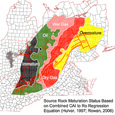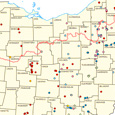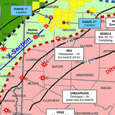Do you know what’s in your water?
Thursday, August 18, 2011
It’s hard to beat a cold glass of clear refreshing water to quench your thirst. I’ve been drinking a lot of water to beat the heat and I imagine you have too. Most of us living in rural Ohio rely on ground water. We just go to our sink or refrigerator and fill a glass and don’t give it a second thought. Maybe we should?
The Ohio Department of Natural Resources Division of Soil and Water Resources reports 700,000 domestic wells are used to supply individual homes throughout the state, which is over 40 percent of Ohioans. The recent shale gas drilling in neighboring Pennsylvania is beginning to spill over into Ohio.
Both Marcellus and Utica Shale formation leases are being sought and test wells drilled. It’s very likely that drilling activity will increase in Ohio.
The Wayne Soil and Water Conservation District has had several inquiries about water testing because of the increasing interest in shale gas drilling. To help landowners find information we have established a page on our website called Landowner Assistance, Oil and Gas. We recommend landowners test private water wells prior to oil and gas drilling to establish baseline data.
The Ohio Environmental Protection Agency, The Ohio Department of Health and ODNR Division of Mineral Resources recently released a new publication called Recommendations for Water Well Sampling Before Oil and Gas Drilling.
Risk
This fact sheet indicates that the chances for groundwater contamination are small because it’s a closely monitored process with regulations in place to protect underground sources of drinking water during and after the drilling process.
It says, “If ground water quality impacts from drilling activities occur, they most often are within a few hundred feet of the drill site.”
The fact sheet also has information on what parameters to test, who regulates oil and gas drilling, and a whole host of other interesting topics. Water samples can be taken by the owner, however, it is recommended that a third party take the sample and follow a “chain of custody” protocol.
A third party could be the well driller at the time of a pump test, an agent of a testing laboratory or a county health department employee. Chain of custody is important should the sample need to be used in litigation. The testing laboratory can provide more information on chain of custody protocol.
A laboratory should also be certified to perform chemical analyses on public drinking water by the Ohio Environmental Protection Agency.
Water level
Another aspect you may want to test is the water well yield in gallons per minute (gpm). We recommend a baseline water level and pumping capacity for each homeowner’s private water well be established prior to the start of natural gas drilling on or near their property.
The water levels in the well should be measured before pumping (static water level), during pumping and for a period of time after the pumping ends (recovery). You can find information reported to ODNR by the well driller when the well was drilled on your well log.
I checked my well log online and found I have a static water level of 145 feet, a test rate of 15 gallons per minute and a test duration of one hour. You can find a copy of your well log at ODNR Division of Soil and Water Resources.
If your well was drilled many years ago, which is often the case, it might be wise to obtain current data should a future change occur that you suspect is from drilling or some other activity.
The recent increase in oil and gas exploration has caused more of us to think about our water, especially groundwater. This isn’t a bad thing because for the most part we take water for granted, maybe we shouldn’t.
Resource Web Sites
Water Well Log Search: www.ohiodnr.com/water/maptechs/wellogs/app/
Wayne SWCD, Landowner Assistance, Oil and Gas: www.wayneswcd.org/landoilgas.html
Recommendations for Water Well Sampling before Oil and Gas Drilling: www.ohiodnr.com/portals/11/publications/pdf/water_well_sampling_fact_sheet.pdf
What is Groundwater: www.dnr.state.oh.us/ContentApproval/GWPPMetaDataButtonScript3227/pubs/fs_div/fctsht24/tabid/4109/Default.aspx
Previous Dirt on Conservation Articles:
We take our well water for granted, March 17th, 2011
Landowners have responsibilities, too, when it comes to oil and gas leases, June 24th, 2010




